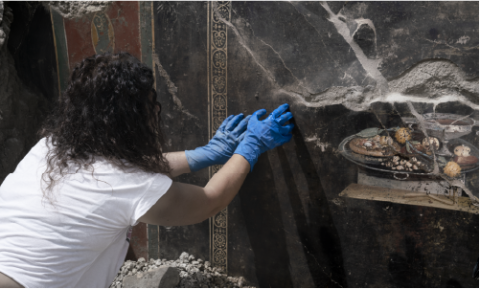
Classical Studies
Classical Studies academics consult for new OU/BBC series ‘Pompeii’

Head of Classical Studies and Senior Lecturer Dr Emma-Jayne Graham and Professor of Archaeology Phil Perkins brought their expertise as academic consultants for new OU/BBC co-production Pompeii: The New Dig, helping demystify the incredible latest findings.
The three-part series, broadcast from Monday, 15 April, on BBC Two at 9pm, follows an all-Italian team of archaeologists as they excavate an entire city block in the north of the city, which was destroyed by the Vesuvian eruption in 79AD. The team aims to unearth the buildings, their purpose, who lived there, and what happened to them during the eruption, in the biggest archaeological excavation in Pompeii for a generation.
The series, told through the drama of the dig and stylised fresco-inspired animations, imagines what life was like in Pompeii before the eruption, as well as the horrors faced by the residents in their final hours.
Beginning with ‘The Bodies’, the team uncovers a large brick-built oven, part of a thriving commercial bakery, one of 40 bakeries found in the city. In the residential part of the building, up to three metres of fresh pumice fills every room. The archaeologists make a shocking discovery of three bodies, killed by a collapsing ceiling. As the archaeologists dig in the atrium, unused roof tiles, bricks and builders' tools come to light - evidence that the building was undergoing renovation at the time of the eruption. The workers fled, abandoning, their tools and leaving their paints still in the pots. The team discovers frescos of Achilles, marble tables, and a richly decorated fresco that depict a ‘pizza’, focaccia with cheese and fruit, making it arguably the first depiction of a pizza across the Roman world.
The series continues with ‘Escape’. The received wisdom is that Pompeii's population was about 10,000-12,000, but in the south of the city, an inscription details a lavish dinner held for over 7000 men, meaning that Pompeii's total population - including women, children and enslaved people - was closer to 30,000. Archaeologists have found just over 1200 bodies, meaning that over 90% of Pompeiians are missing. Experts have found very few remains of horses or carts that once packed the city, meaning that many Pompeiians probably used them to escape in the early phase of the eruption - the name of a prominent fish sauce (garum) maker found on some ancient pots is later found on a gravestone 20 miles from Pompei, dating 20 years after the disaster.
Ending with ‘The Final Hours’, intricately drawn images of Gladiators in combat drawn just before the eruption in charcoal, which fades quickly, are found under a set of stairs. Two large snakes – a powerful symbol of protection - rendered in relief in three-dimensional plaster, something never before found in Pompeii, and a small shine, an altar and the charred remains of an offering are also uncovered. The last find in the main complex is the most exciting - political slogans written in red letters across the walls, asking the Pompeiians to vote for Aulus Rustius Verus, the same initials found earlier on a bakery millstone.
Dr Emma-Jayne Graham, who worked with Phil Perkins as academic consultants on the series, noted that “one of the most exciting things about making this series was the chance to demystify an archaeological excavation and show how completely unexpected stories about Roman people can emerge alongside newly discovered artefacts.
“Working closely with the production team on the scripts and the striking fresco-style animations was a great way of joining those aspects together to bring new interpretations of Pompeian society to life.”
Discover more about the series and our academic experts, and walk alongside an ancient Roman in a guided interactive tour of Pompeii on OU Connect
Request your prospectus
![]()
Explore our qualifications and courses by requesting one of our prospectuses today.
